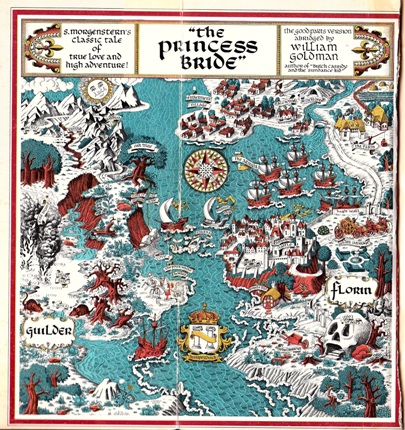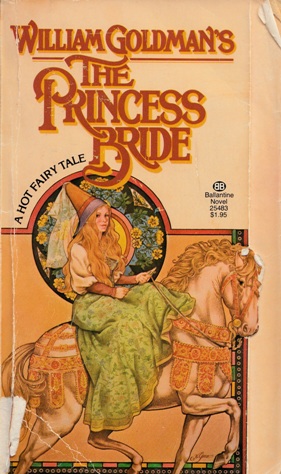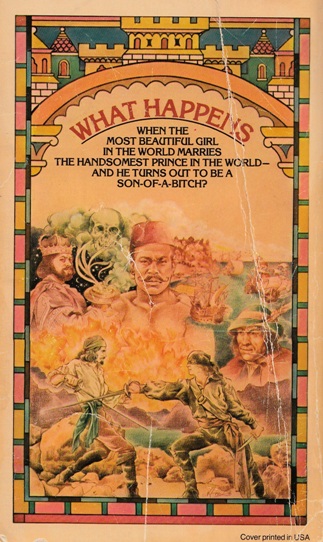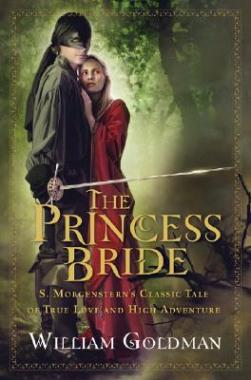I’m currently having a minor internal dilemma, dear readers, that I wanted to run past you. The dilemma revolves around my desire to share William Goldman‘s tremendous fairy tale, The Princess Bride, with my six-year-old daughter, and how exactly I should do that. Like a lot of people from my generation, I discovered The Princess Bride thanks to Rob Reiner’s 1987 film adaptation, an epic adaptation that has endured as one of the most rewatchable, quotable, and downright iconic movies of the past thirty years. While I’m still debating when my daughter will be old enough to see the movie, my primary concern is how and when I’m going to read Goldman’s original book to her.
And the operative word in that sentence is “how.” Because, at the moment, I don’t think I want to read her the entire book. I think I only want to read her the “good parts” of The Princess Bride, a statement that anyone who’s read the original book will find funny, ironic, or, at the very least, very, very “meta.”
Now, as a professed “book person”, the idea of selectively reading passages of a book to my daughter feels like a big cheat and a huge violation of the unspoken bond between author and reader – I hate playing backseat editor – but The Princess Bride is a special case. Let me give you some back story…
Even though I adored The Princess Bride movie the first time I saw it in 1987, it never really landed with me that I should seek out the original book that it was based on until I was in college. After a few weeks of hunting, I came across a tattered paperback copy of Goldman‘s The Princess Bride in a used bookstore and quickly devoured it. (It was originally published in 1973 with the eyebrow-raising tagline “A Hot Fairy Tale.”)
And the book didn’t disappoint. It’s wonderful. When reading the book, you really get an appreciation for how faithful and spot-on Rob Reiner’s adaptation was. Princess Bride the book is INCREDIBLY similar to Princess Bride the movie, right down to the priest mispronouncing “Mawidge” to the now-legendary “Hello, My Name is Inigo Montoya” showdown (which reaches its climax on page 276 of my paperback). While there are little variations in the details here and there, I can only recall two MAJOR differences that stood out when I first read the book.
The first is a sequence that didn’t make it into the film probably due to time, story, and budget constraints – a long sequence that revolves around Inigo and Fezzik breaking into Prince Humperdink’s Zoo of Death to rescue Westley from The Machine. (The idea is that Humperdink has an underground zoo with multiple levels – each progressive level holds deadlier and deadlier creatures. And, of course, at the bottom is where he keeps the deadliest creature, i.e. Westley.) Aside from that one major scene being deleted, the movie version of The Princess Bride follows the book’s fairy tale story nearly beat-for-beat.
The second big difference is the whole framing narrative of the fairy tale, a framing story that plays out similarly to the Fred Savage/Peter Falk scenes from the movie. In the movie version, we have a grandfather reading The Princess Bride to his sick grandson, while the grandson keeps interrupting him and injecting commentary on the plot. The framing story of the book is even more metatextual than the movie. To give you an idea, the full subtitle of the book is “S. Morgenstern’s Classic Tale of True Love and High Adventure – The ‘Good Parts” Version, Abridged by William Goldman.”
Goldman opens the book with the fantastic first line:
This is my favorite book in all the world, though I have never read it.
What follows is a 29-page prologue in which Goldman sets the stage, writing in a first-person exaggeration of his real self. The fictionalized premise is that Goldman, as a child, hated to read. So, once, when the young Goldman was sick with pneumonia, his father sat down and read him S. Morgenstern’s classic fairy tale The Princess Bride. (In this version of history, both Morgenstern and Goldman’s father were born in Florin, the fictional setting of the story.) When Goldman is an adult, now a successful screenwriter, he gets a copy of The Princess Bride to read to his apathetic son and makes a startling discovery – his father had only read him the “good parts” of Morgenstern’s original tale.
Apparently, Morgenstern’s version of The Princess Bride was a big, dense historical and political allegory that would go on in minute detail, for pages and pages, all about the period clothing, the monarchy, and Florinese history. To quote Goldman:
The more I flipped on, the more I knew: Morgenstern wasn’t writing any children’s book; he was writing a kind of satiric history of his country and the decline of the monarchy in Western civilization.
But my father only read me the action stuff, the good parts. He never bothered with the serious side at all.
His father took out all the social commentary and left in all the good stuff like (to quote Goldman again): “Fencing. Fighting. Torture. Poison. True love. Hate. Revenge. Giants. Hunters. Bad men. Good men. Beautifulest ladies. Snakes. Spiders. Beasts of all natures and descriptions. Pain. Death. Brave men. Coward men. Strongest men. Chases. Escapes. Lies. Truths. Passion. Miracles.” So, as the premise goes, Goldman sets out to write a “good parts only” version of The Princess Bride to share with his son and the result is The Princess Bride that we all know and love.
After the long prologue, the fairy tale itself begins, with Goldman checking in occasionally (in long italicized passages) where he either explains what he cut of the text in certain sections or he recounts his son’s comments while hearing the story for the first time (just like Fred Savage’s asides during the movie).
It’s an inspired concept, a concept that I adored when I first read The Princess Bride, but, as I re-read the story recently, I had mixed feelings about it.
My issue is that I think The Princess Bride is one of the best original fairy tales I’ve ever read. It’s modern and classical all at the same time, a truly timeless story, and I think it’s just as good as any old school fairy tale that Charles Perrault or The Brothers Grimm ever told.
But that framing narrative – Goldman’s first-person asides – in my opinion, it sells the story short. It feels like Goldman is qualifying his storytelling, like he feels the need to interject faux Hollywood anecdotes or witty meta-commentary to excuse the fact that he wants to tell a fairy tale to an audience of adult readers.
There is some beautiful prose in Goldman‘s asides and his commentary is achingly perceptive at times. However, the recurring joke about how much he had to cut from Morgenstern’s original version drags after the third time you hear it and the foreword, in particular, has sections that are already terribly dated. There’s talk of 1970s Hollywood, Goldman being hit on by starlets, his son “eating his feelings” (i.e. being tremendously overweight), and a lot of fast-talking period vernacular that, in my head, just comes out in silky voice of producer Robert Evans (the worst of which is probably “You’re making a poof out of that kid”).
It’s not bad at all, it is legitimately funny, and it is obviously exaggerated for comedic effect, but it just can’t hold a candle to the fairy tale it surrounds. It’s like bookending a showing of Citizen Kane with two mid-grade episodes of Seinfeld. Or it’s like having a stand-up comedian opening for Prokofiev’s “Peter and the Wolf”, a comedian who keeps interrupting the symphony to occasionally crack wise.
In my mind, Goldman’s problem is that his fairy tale is TOO GOOD. It outshines the framing narrative to such a degree that I personally want to throw it to the curb entirely and find a way to convince my daughter that the tale of The Princess Bride has been around just as long as Cinderella or Little Red Riding Hood.
So, let me throw some questions out to you, faithful readers:
- Do you think William Goldman should ever publish an edition of The Princess Bride WITHOUT his framing narrative and asides? An edition with only the fairy tale itself?
- And, since that edition doesn’t exist, how do you think I should handle introducing The Princess Bride to my daughter? Should I just read to her from my 1973 original version, skipping over whatever sections I don’t care for and hoping she doesn’t notice? (And, if she does notice, pushing ahead anyway?)
- Or, should I respect the completeness of Goldman’s vision, and not introduce The Princess Bride to her until she’s old enough to appreciate every single aspect of the original, including all the mentions of Rosemary’s Baby and starlet Sandy Sterling’s ample figure?
Much like all those voters I despised in the November election, I am legitimately undecided at the moment, though it’s such a first-world problem to have, I’m not sweating it too much. More than anything else, I am just such a huge fan of what Goldman accomplished in the fairy tale sections of The Princess Bride that I know that SOMEHOW I will share them with my daughter one day.

I love this “world of the story” map from my 1970s paperback edition of “The Princess Bride.” Click to embiggen the map.
Yes, the movie was amazing and, c’mon, how fantastic was Wallace Shawn – BUT – even though Rob Reiner’s Princess Bride made an indelible contribution to film history, I think William Goldman‘s profoundly underrated Princess Bride deserves to recognized for its own timeless contribution to literary history. It is, simply put, one of the most breathtakingly original fairy tales of the past century. And I worry that Goldman’s accomplishment with The Princess Bride is often overlooked because it has to sit on a double-bill with a mildly charming comic memoir.
Goldman’s Hollywood memoirs are hysterically funny reads, but The Princess Bride is a transcendent piece of folklore that, in my opinion, should be read more often to young readers. But how will that happen? Does there need to be a framing-free edition of the story? Or do parents just need to treat Goldman the same way Goldman treated the fictional S. Morgenstern and only read their kids the “good parts” of his 1973 classic? When I finally make my own decision, I’ll be sure to let you know…
(And, not to toot my own horn, but do you know how hard it was to write this post without making an “inconceivable” joke at some point? It was brutal. On an unrelated note, anybody want a peanut?)



{ 9 comments… read them below or add one }
I loved reading your article!! I’m from Germany and I first discovered the book when I was maybe 12/13 years old.
I fell in love with it completely. The combination of fairytale, adventure and intersections about life being not fair was so bitter sweet and so lovely. It gave me the grown-up feeling of having some inside information just in the right amount not to being demotivating or frustrating.
I think the story shines the brightest in the whole “meta” story but I would also love the introduce kids as soon as possible.
There can’t be a wrong decision here I think
anyway loved reading your article – even if I am late to the game
Back in the 80, when I was a teen I read the book version before the movie came out and when I got to the end of the book, someone had torn the last page. Devastation and anger twisted together as one. I pondered, which of my five siblings had stooped to such a malicious act of treason. My life crumbled before me. The movie was unlike the book. I cried when Wesley died and when I watched the movie, not one tear fell down. I swore never to read another book without looking to see if the last page was there, first. I admit, this incident scarred me for life, but this, too, shall pass.
I love Princess Bride – it’s my favorite movie and one of my top favorite books. I introduced my 2.5 year old to the movie (skipping the bloody stabbing at the end and some of the fire swamp scenes) and she LOVES it. Her favorite part, strangely, is when Buttercup is blindfolded and Fezzick does the infamous “land war in Asia” bit. I don’t think there’s anything wrong with introducing the book to her now and skipping parts – I agree with Josh that when she’s old enough to read it on her own, those parts will make it seem new again.
I have shown the movie to my girls (4 and 6) so that they will understand more of my jokes (like Heather D.). I read the book to them when they were babies, and have been thinking about reading to them again now. I will probably cut out the commentary and stick with the fairy tale, so that they may discover the additional magic at some later time.
I don’t know where you landed on this, but I let — MADE — my 6yo girl watch the movie a few months back. Because of this post, I probably will start in on the book with her and cut out the framing bits.
Oh cool. We showed our 6yo girl “Princess Bride” last month and she ADORED it. The best part was – she was getting really, really nervous during the shrieking eels scene and, right as she was about to bury her head in a pillow, Peter Falk interrupted the story and asked Fred Savage if he was OK… which was hilarious because we were just about to do the exact same thing. That one little aside cracked my kid up and, after that, you could tell she was sitting there, thinking, “I love this movie.”
I’m with you – now that she likes the movie so much, I think I am going to read her the story WITHOUT the framing narrative. Part of me feels like I’m betraying the author’s intent, but… I’m OK with it. My daughter just loves the fable SO much and I really don’t want to read her 60+ pages of 1970s inside Hollywood jokes while a fictional William Goldman considers cheating on his wife with a fictional starlet.
No. I’m sorry, but you must wait.
Just as you had to wait when you were pregnant to meet your little bundle of joy.
Or when you purchase the perfect present and you can’t wait to give it to them.
Patience.
Your time will come.
That’s tough, but fair.
You raise some interesting points. I’m not sure I ever thought of reading The Princess Bride to my boys. I have introduced them to the movie (they are 7 and 11) mostly so they would get my jokes.
I let my kids watch superhero movies and action flicks, so I’m not the best person to ask as to when would be a good time to introduce your daughter to the movie. And I think this is one of those rare times where I would watch the movie before reading the book. Those asides can really distract from the story, and you may end up with her hating the story. You can skip parts, but that’s hard to do. You start reading, and you get half way through a passage before you realize, “Oh I didn’t want to read this part.” At least that’s how it works for me.
I bet that wasn’t very helpful. Sorry! Maybe you should go watch the movie again to help you decide what to do
You must log in to post a comment.